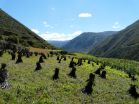(Press-News.org) Casting a large interdisciplinary research net has helped Simon Fraser University archaeologist Dana Lepofsky and 10 collaborators dig deeper into their findings about ancient clam gardens in the Pacific Northwest to formulate new perspectives.
Lepofsky's research team has discovered that Northwest Coast Indigenous people didn't make their living just by gathering the natural ocean's bounty. Rather, from Alaska to Washington, they were farmers who cultivated productive clam gardens to ensure abundant and sustainable clam harvests.
In its new paper published by American Antiquity, Lepofsky's team describes how it isolated novel ways to date the stone terraces that created clam beaches. These beaches are certainly more than 1,000 years old and likely many thousands of years older. The researchers identified many places where people built gardens on bedrock -- creating ideal clam habitats where there were none before. This, the researchers concluded, clearly challenges the notion that First Nations were living in wild, untended environments.
"We think that many Indigenous peoples worldwide had some kind of sophisticated marine management, but the Pacific Northwest is likely one of the few places in the world where this can be documented," says Lepofsky. "This is because our foreshores are more intact than elsewhere and we can work closely with Indigenous knowledge holders."
The researchers, who worked with First Nations linguistic data, oral traditions and memories, geomorphological surveys, archaeological techniques and ecological experiments, belong to the Clam Garden Network. It's a coastal group interested in ancient clam management.
"Understanding ancient marine management is relevant to many current issues," says Lepofsky.
Her team is comparing clam garden productivity to that of modern aquaculture and assessing whether the shell-rich beaches of clam gardens help buffer against increasing ocean acidification. The team will also build experimental clam gardens, applying many of the traditional cultivation techniques learned from First Nations collaborators as a means of increasing food production and food security today.
This latest study is on the heels of one done a year ago by Lepofsky and her collaborators. The original three-year study published in PLOS ONE found that these ancient gardens produced quadruple the number of butter clams and twice the number of littleneck clams as unmodified clam beaches. It was the first study to provide empirical evidence of the productivity of ancient Pacific Northwest clam gardens and their capacity to increase food production.
The Tula Foundation, Parks Canada, the Social Sciences and Humanities Research Council and Wenner Gren, among other groups, are funding the team's studies.
Key highlights of new study:
Northwest Coast Indigenous peoples from Alaska to Washington State managed clam beaches in a variety of ways. These included replanting of small clams and building rock terrace walls at the low-low tide line to create clam gardens.
Northwest Coast First Nations language terms indicate clam gardens were built in specific places by rolling the rocks for two purposes. One was to create rock-walled terraces ideal for clam growth. Another was to clear the beaches of unwanted rubble that would limit clam habitat.
The researchers developed novel ways to date the clam gardens and their preliminary excavations revealed that many date to more than 1,000 years ago.
Working on these clam gardens posed some logistical challenges since many are only visible for about 72 daylight hours per year.
Extensive air and ground surveys revealed that clam gardens can be found from Alaska to Washington State, but in some places, such as the Gulf Islands, recent rising sea level obscures the rock walls. In some areas, clam gardens made possible the dense ancient First Nations settlements that dot our coastline.
INFORMATION:
As Canada's engaged university, SFU is defined by its dynamic integration of innovative education, cutting-edge research and far-reaching community engagement. SFU was founded almost 50 years ago with a mission to be a different kind of university--to bring an interdisciplinary approach to learning, embrace bold initiatives, and engage with communities near and far. Today, SFU is a leader amongst Canada's comprehensive research universities and is ranked one of the top universities in the world under 50 years of age. With campuses in British Columbia's three largest cities--Vancouver, Surrey and Burnaby--SFU has eight faculties, delivers almost 150 programs to over 30,000 students, and boasts more than 130,000 alumni in 130 countries around the world.
Contact:
Dana Lepofsky (Vancouver resident), 604.929.6678, dlepofsk@sfu.ca
Carol Thorbes, University Communications, 778.782.3035, cthorbes@sfu.ca
Note: Media can obtain this published paper on request by emailing the researcher or University Communications.
Photos: http://at.sfu.ca/YPYNMN
Video: http://youtu.be/eWvkmcsXhtQ
Being bigger and bolder holds various benefits for male soldier beetles. They enjoy higher rates of successful courtship and more often land a larger, more fertile mate. These are some of the findings of a study led by Denson McLain of the Georgia Southern University in the US, published in Springer's journal Behavioral Ecology and Sociobiology.
The goldenrod soldier beetle or Pennsylvanian leatherwing (Chauliognathus pennsylvanicus) is native to Northern America. During its peak reproductive season, between September to early October, it only mates once a day. This normally ...
CHICAGO -- Genetic testing of Iñupiat people currently living in Alaska's North Slope is helping Northwestern University scientists fill in the blanks on questions about the migration patterns and ancestral pool of the people who populated the North American Arctic over the last 5,000 years.
"This is the first evidence that genetically ties all of the Iñupiat and Inuit populations from Alaska, Canada and Greenland back to the Alaskan North Slope," said Northwestern's M. Geoffrey Hayes, senior author of the new study to be published April 29, 2015, in the American ...
PULLMAN, Wash.--Climate change may be responsible for the abrupt collapse of civilization on the fringes of the Tibetan Plateau around 2000 B.C.
WSU archaeologist Jade D'Alpoim Guedes and an international team of researchers found that cooling global temperatures at the end of the Holocene Climatic Optimum, a 4,000 year period of warm weather, would have made it impossible for ancient people on the Tibetan Plateau to cultivate millet, their primary food source.
Guedes' team's research recently was published online in the Proceedings of the National Academy of Sciences. ...
A vaccine containing a protein necessary for virus replication can boost an HIV-infected patient's immune system, according to clinical research published in the open access journal Retrovirology. This boost can result in increased effectiveness of antiretroviral drugs.
When people are first diagnosed with HIV they are put on antiretroviral drugs, also known as highly active antiretroviral therapy (HAART). These drugs can stop the virus reproducing almost completely. When taking HAART, however, it is known that the virus can still replicate at low levels and accumulate ...
For patients in the early stage of non-small cell lung cancer, surgical resection yields optimal outcomes. Prior investigations have shown that different resection procedures have very different outcomes, with pneumonectomy associated with three-fold higher mortality than other resection types. While it is understandable that pathological and physiological factors influence a surgeon's choice of surgery for a particular patient, the results presented in this study suggest that physician discomfort with the operative complexities of a procedure may lead to selection of a ...
Hospital readmission rates after major thoracic surgery can run as high as 10-17%. Alarmingly, readmission after pulmonary resection for lung cancer has been associated with worse outcomes, including higher mortality. Thus, reducing readmissions after thoracic surgery can both save lives and reduce healthcare costs. Studies in internal medicine and cardiology have shown that programs that improve the transition from hospital to post-discharge care can be effective in decreasing emergency room visits and re-hospitalization. This study from McMaster University describes for ...
People suffering from the common lung disease, chronic obstructive pulmonary disease (COPD), have an increased risk of sudden cardiac death (SCD), according to new research published online today (Wednesday) in the European Heart Journal [1].
When compared with people of the same age and sex who do not have the disease, those with COPD have a 34% increased risk of SCD overall, but their risk almost doubles more than five years after first being diagnosed with COPD. In COPD patients who have frequent exacerbations (sudden worsening of their symptoms, such as shortness ...
Marine ecosystems can be changed by night-time artificial lighting according to new research published in the Royal Society journal Biology Letters. The results indicate that light pollution from coastal communities, shipping and offshore infrastructure could be changing the composition of marine invertebrate communities.
Researchers from the Universities of Exeter and Bangor used a raft in the Menai Strait to monitor how artificial light at night affects the settlement of marine invertebrates into new habitats. Light is an important cue which guides the larvae of marine ...
New research by scientists at New Zealand's University of Otago suggests a need for a fundamental rethink of the evolutionary path of enzymes, the proteins vital to all life on Earth.
Enzymes catalyse a vast array of biologically relevant chemical reactions even in the simplest living cells.
Biochemist Dr Wayne Patrick says that people tend to imagine evolution as a slow and steady march from barely functional life forms in the primordial soup, towards a modern-day pinnacle of near perfection.
"When it comes to enzyme evolution, this is also the textbook version ...
MORE than two-thirds (69 per cent) of bowel cancer patients say they weren't advised to exercise regularly after their diagnosis - despite evidence that brisk physical activity is linked to better survival in bowel cancer, according to a Cancer Research UK study published today (Wednesday) in BMJ Open.
The research, from the Cancer Research UK Health Behaviour Research Centre at UCL (University College London), is the largest study of its kind. More than 15,000 bowel cancer patients* were asked about their current level of physical activity and whether they were advised ...

